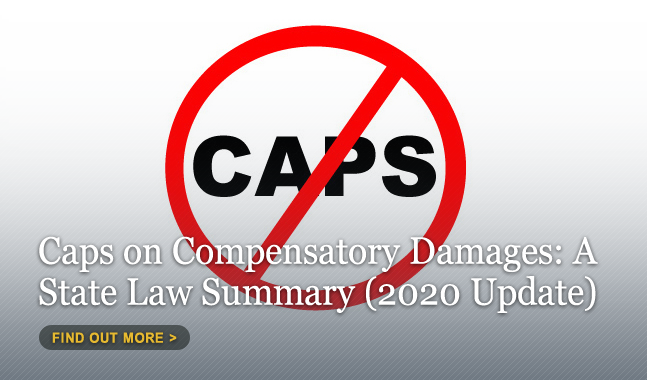

It is difficult to compare state laws that cap compensation to victims in civil lawsuits. Most “cap” laws focus on non-economic damages,[1] although some state medical malpractice laws cap total damages (both economic[2] and non-economic). “Caps” also vary in size.
Many states exempt certain factual scenarios or specific types of claims from application of a state’s cap. Some state high courts have examined the constitutionality of caps, while others have not. And some states have re-passed caps after their courts found them unconstitutional, often making the constitutionality of such caps unclear.
With that in mind, the following is a general rundown of current state laws that cap compensatory damages.[3]
GENERAL TORT OR PERSONAL INJURY CASES[4]
Non-economic damages caps (8 states)
Caps found unconstitutional; legislatures haven’t re-passed them (7 states)
No caps (42 states plus DC)
AL, AZ, AR, CA, CT, DC, DE, FL, GA, IL, IN, IA, KS, KY, LA, ME, MA, MI, MN, MO, MT, NE, NV, NH, NJ, NM, NY, NC, ND, OK, OR, PA, RI, SC, SD, TX, UT, VT, VA, WA, WV, WI, WY
PRODUCTS LIABILITY CASES
Non-economic damages caps (8 states)
Caps found unconstitutional; legislatures haven’t re-passed them (7 states)
No caps (42 states plus DC)
AL, AZ, AR, CA, CT, DC, DE, FL, GA, HI, IL, IN, IA, KS, KY, LA, ME, MA, MN, MO, MT, NE, NV, NH, NJ, NM, NY, NC, ND, OK, OR, PA, RI, SC, SD, TX, UT, VT, VA, WA, WV, WI, WY
MEDICAL MALPRACTICE CASES
Total caps (i.e., caps encompassing economic and non-economic damages, although some exempt future medical care)(6 states)
Non-economic damages caps (23 states)
AK, CA, CO,[11] HI,[12] IA, ID, MA, MD, MI, MO,[13] MS, MT, NC, ND,[14] NV, OH,[15] SC, SD,[16] TN, TX, UT, WV, WI[17]
Caps found unconstitutional; legislatures haven’t re-passed them (9 states)
No caps (22 states plus DC)
AL, AZ, AR, CT, DC, DE, FL, GA, IL, KS, KY, ME, MN, NH, NJ, NY, OK, OR, PA, RI, VT, WA, WY
STATES WITH CONSTITUTIONAL PROVISIONS PROHIBITING CAPS
General torts (5 states)
Wrongful death only (4 states)
NOTES[1]Non-economic injuries include permanent disability, mutilation, trauma, loss of a limb, blindness, sexual or reproductive harm and other types of suffering and pain.
[2]Economic loss is primarily lost earnings and medical expenses.
[3]Caps on punitive damages are not included in this analysis.
[4]Some states have separate laws capping damages in products liability or medical malpractice cases.
[5]Cap applies to “pain and suffering” only. Other kinds of non-economic damages are not capped.
[6]Re-passed after being found unconstitutional.
[7] Found unconstitutional, court reversed itself much later, and then distinguished that case in a later case.
[8]Re-passed after being found unconstitutional.
[9] Found unconstitutional, court reversed itself much later, and then distinguished that case in a later case.
[10]CO also has a separate non-economic damages cap.
[11]CO also has a separate “total” cap.
[12]Cap applies to “pain and suffering” only. Other kinds of non-economic damages are not capped.
[16] One cap found unconstitutional but another cap is still law.
[17] Re-passed after being found unconstitutional and then upheld as constitutional.
[18] Found unconstitutional, court reversed itself much later, and then distinguished that case in a later case.
![]()
Fact Sheet: Caps On Compensatory Damages: A State Law Summary